
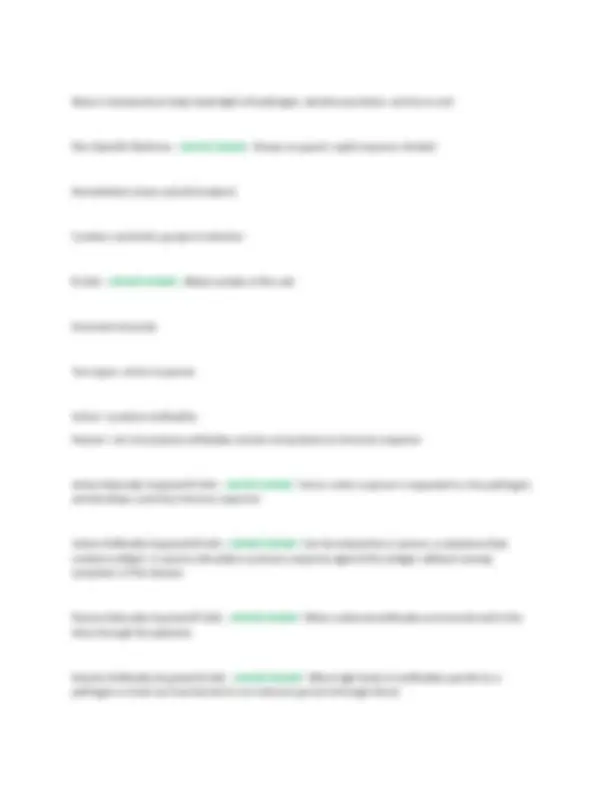
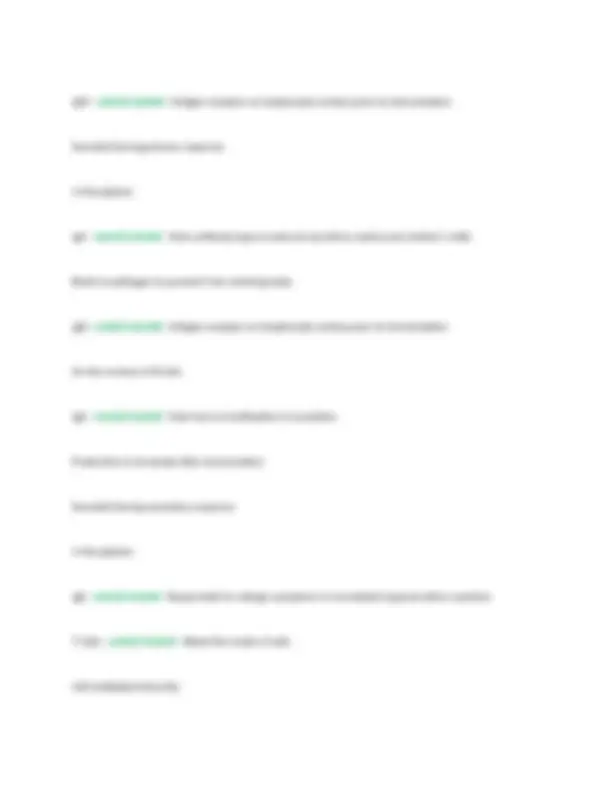
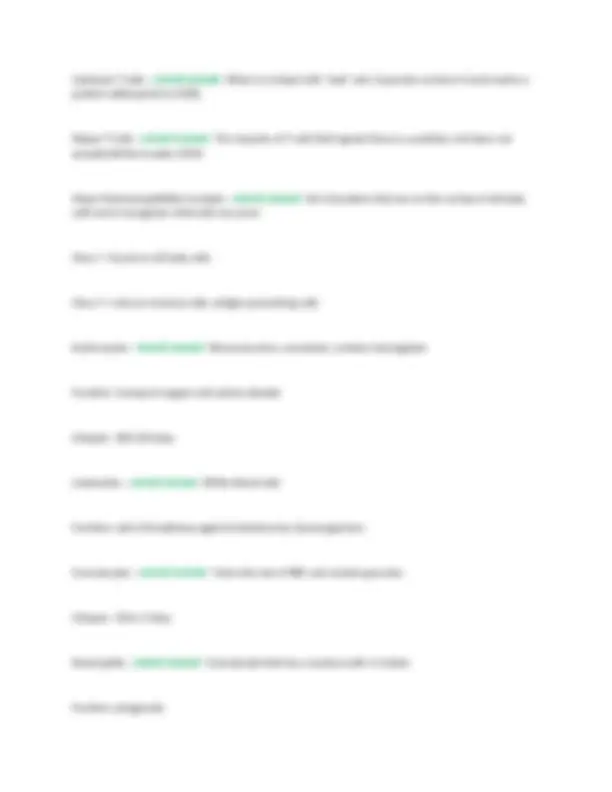
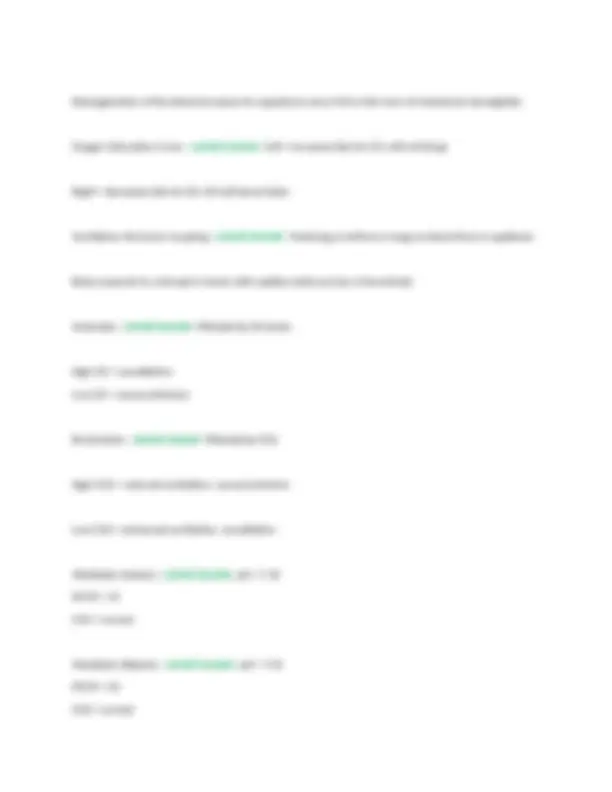
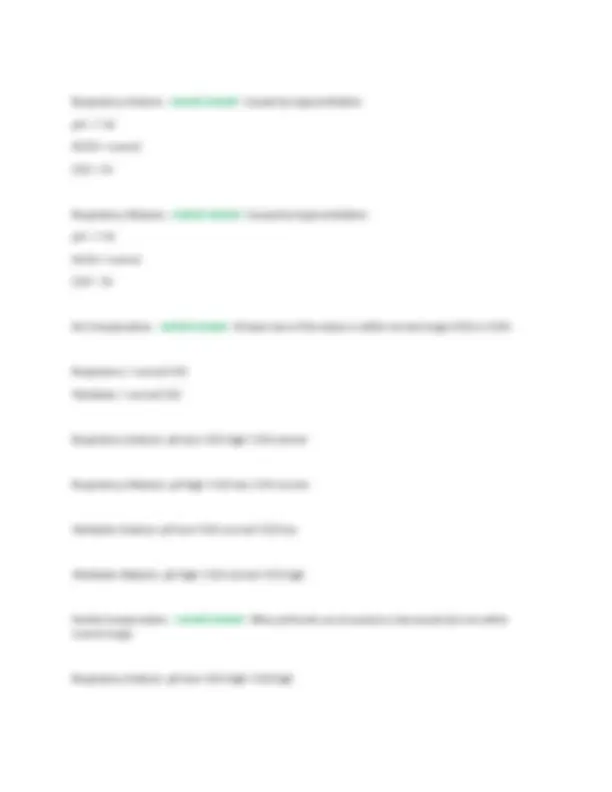
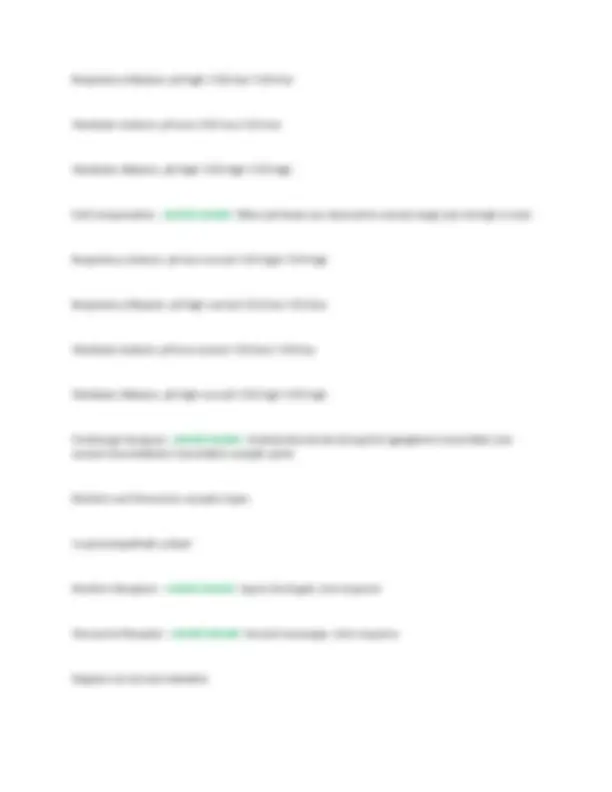
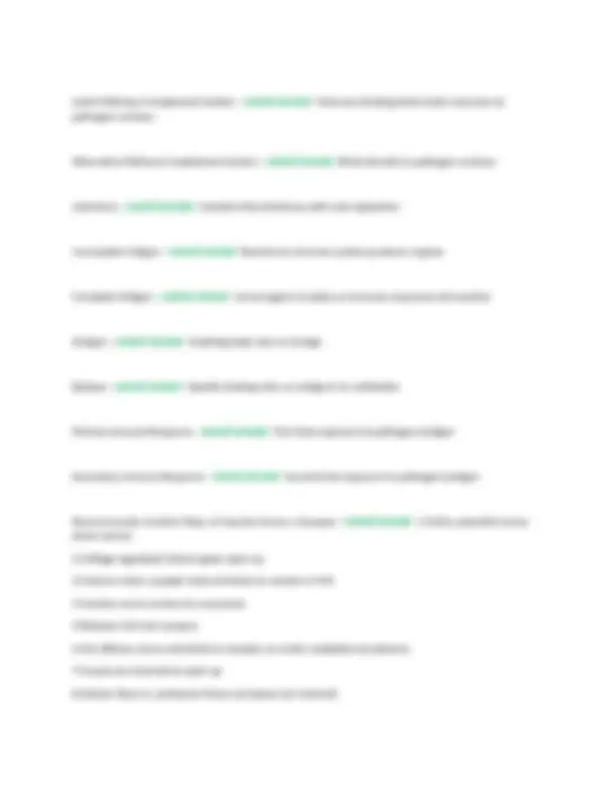
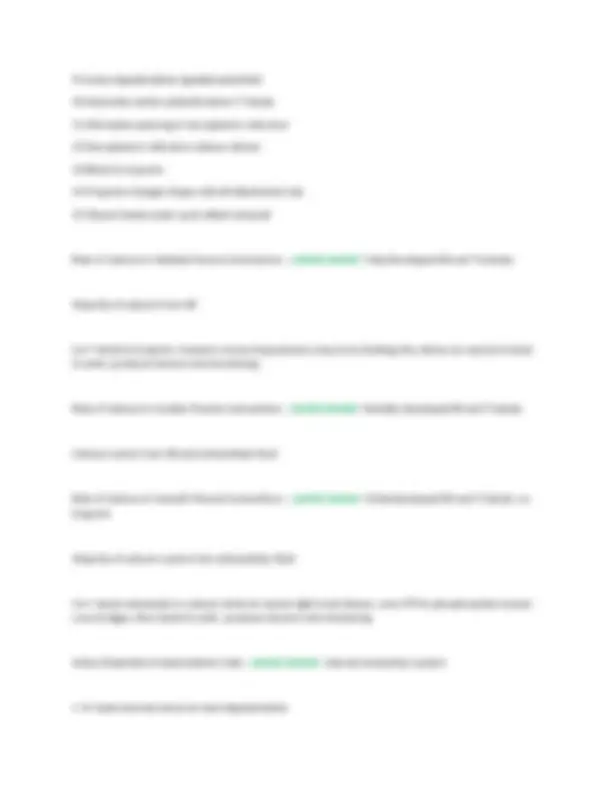

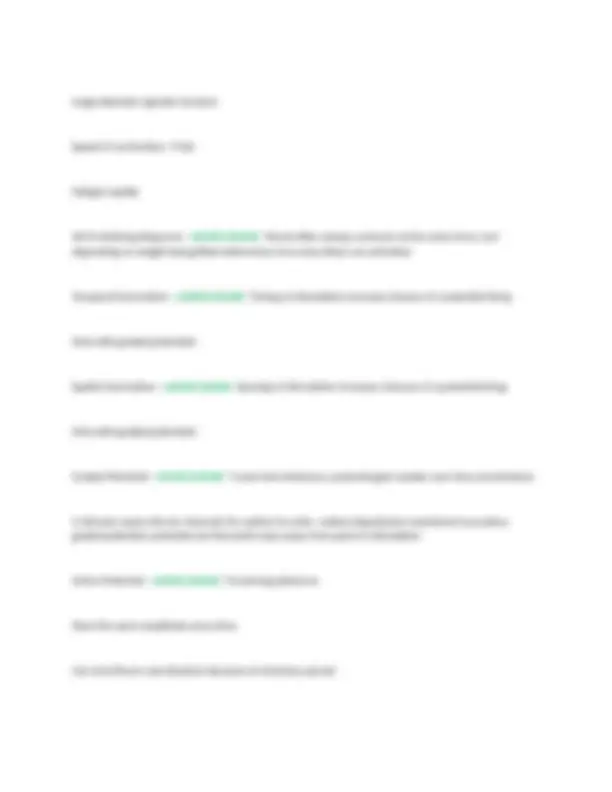
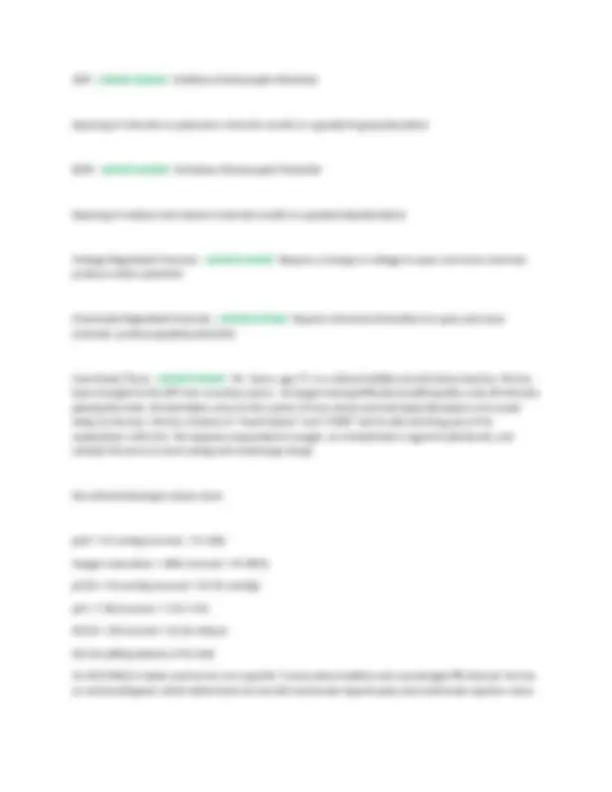

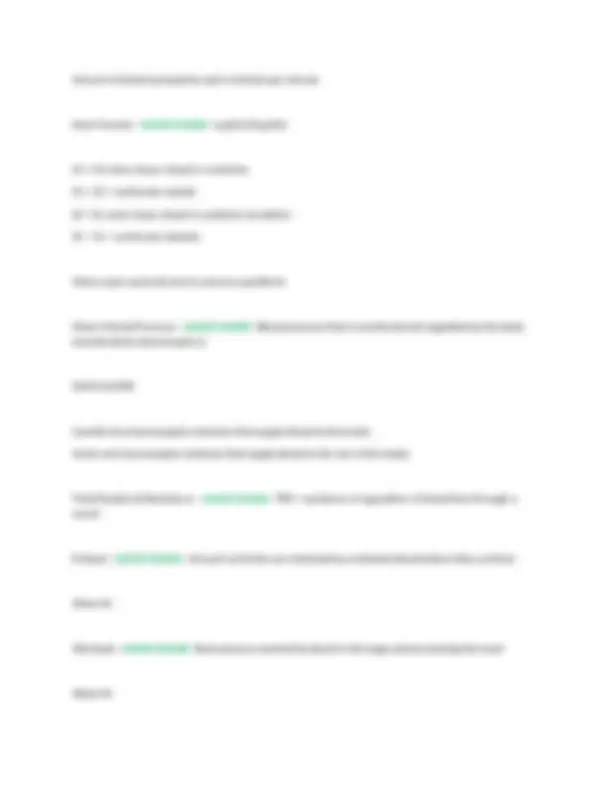
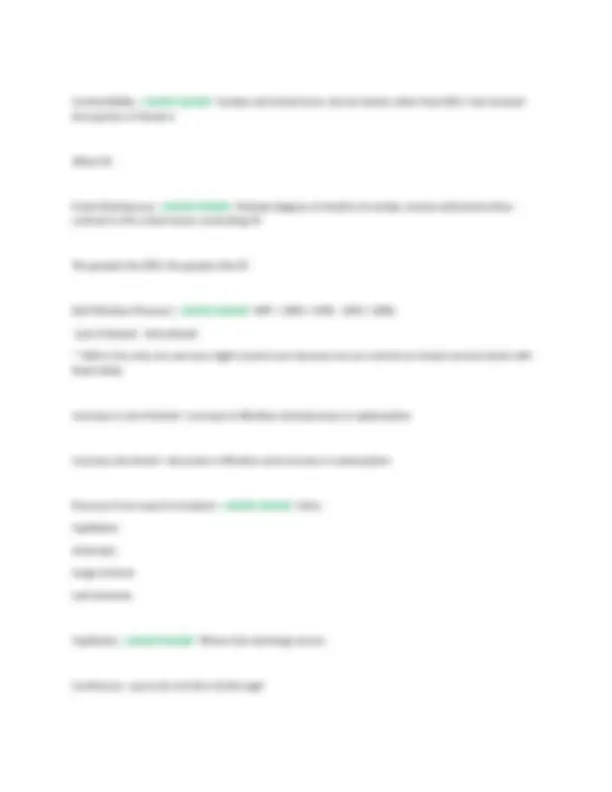
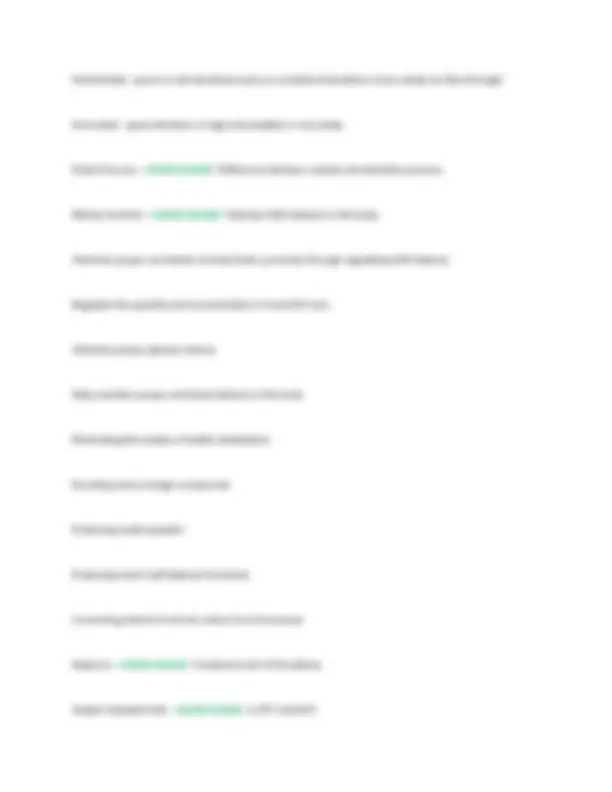
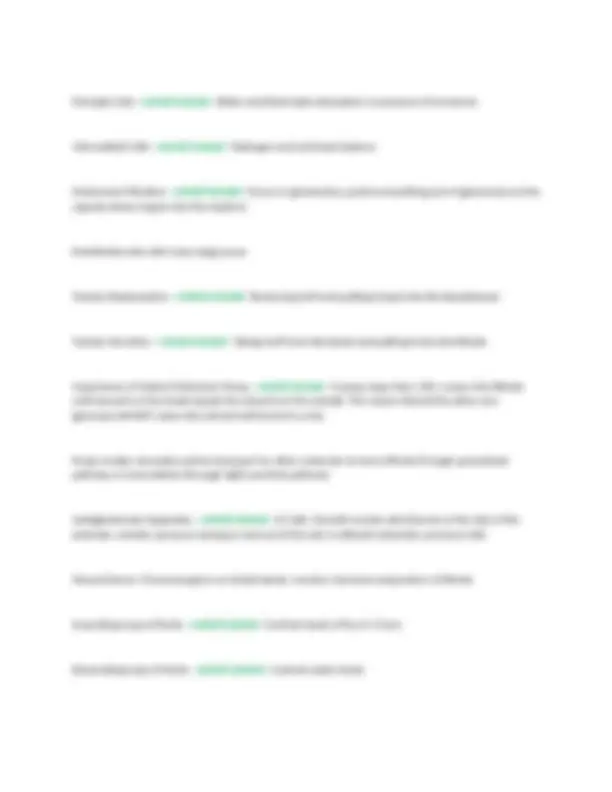
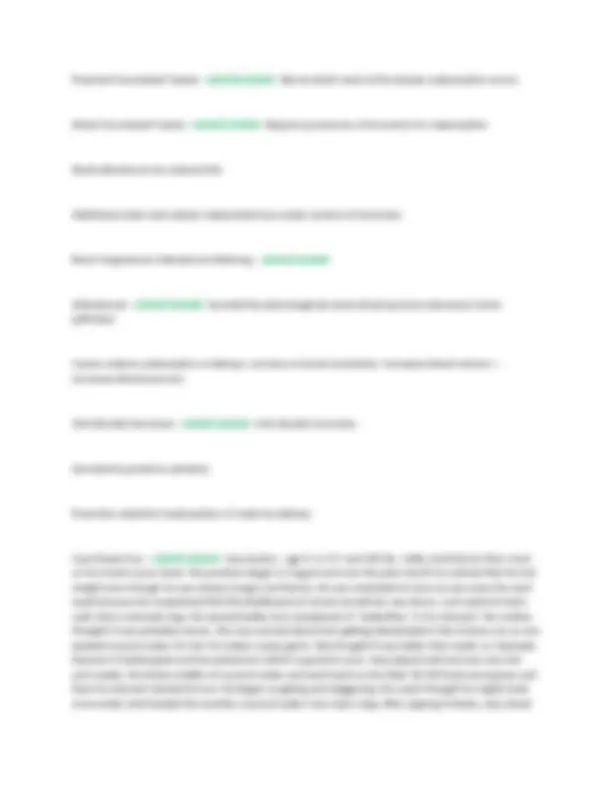
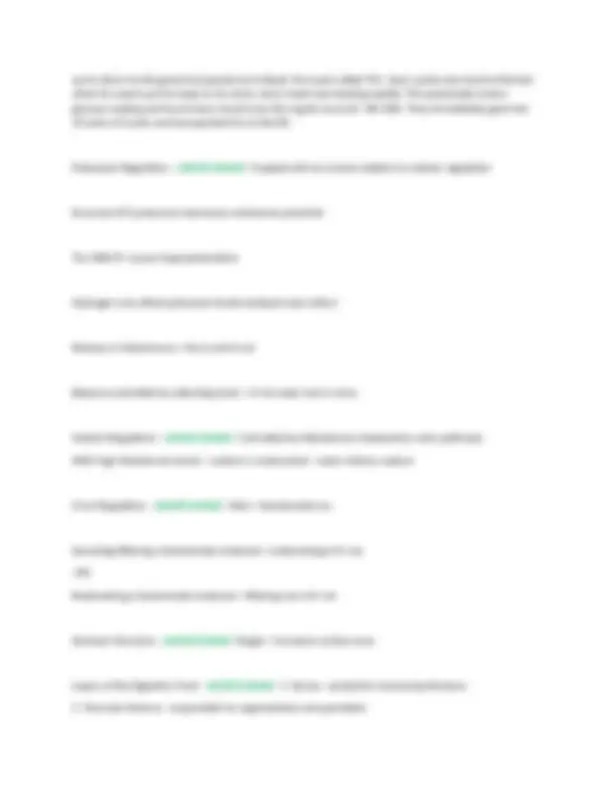
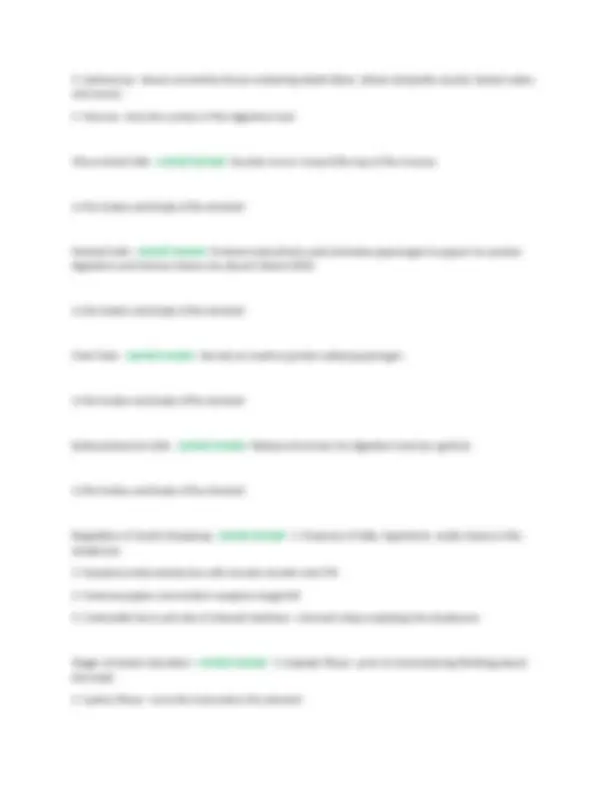
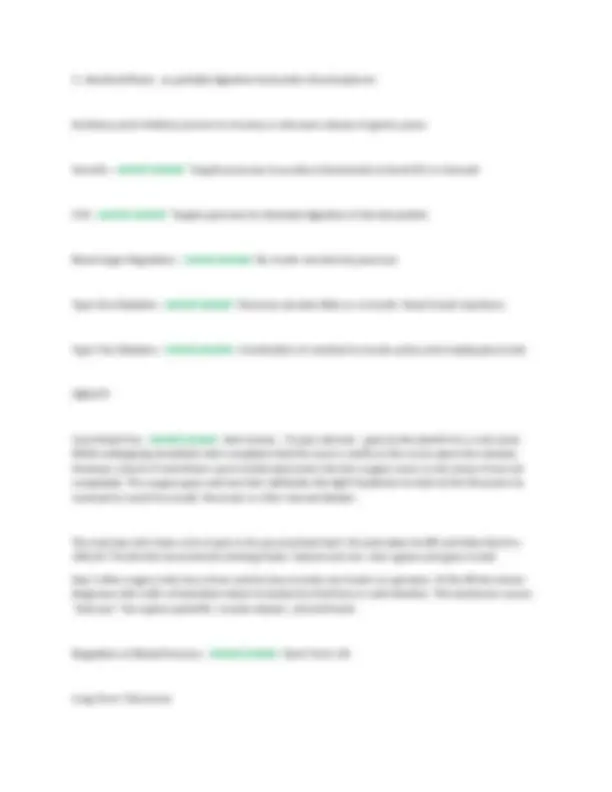
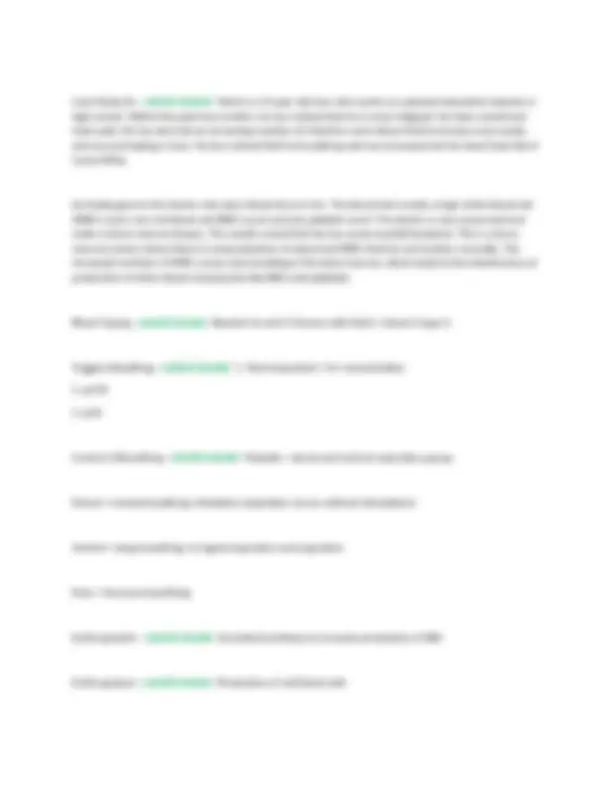

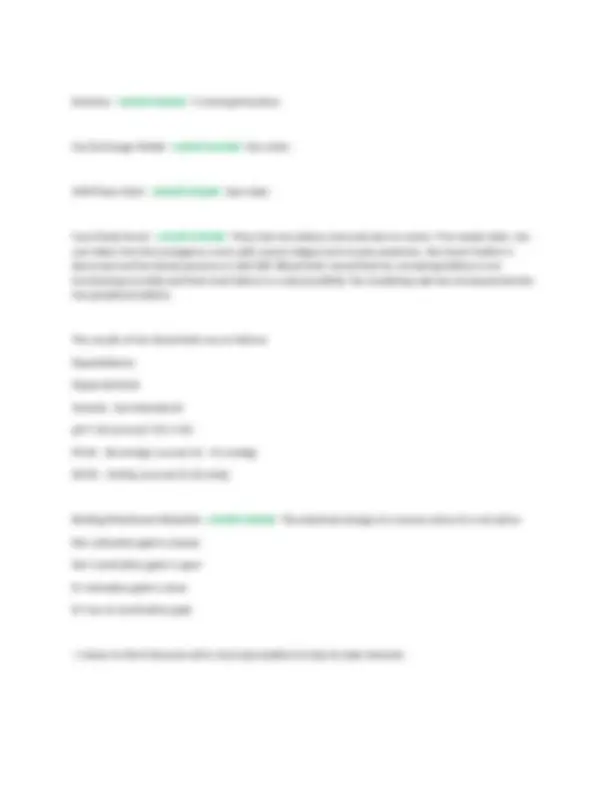

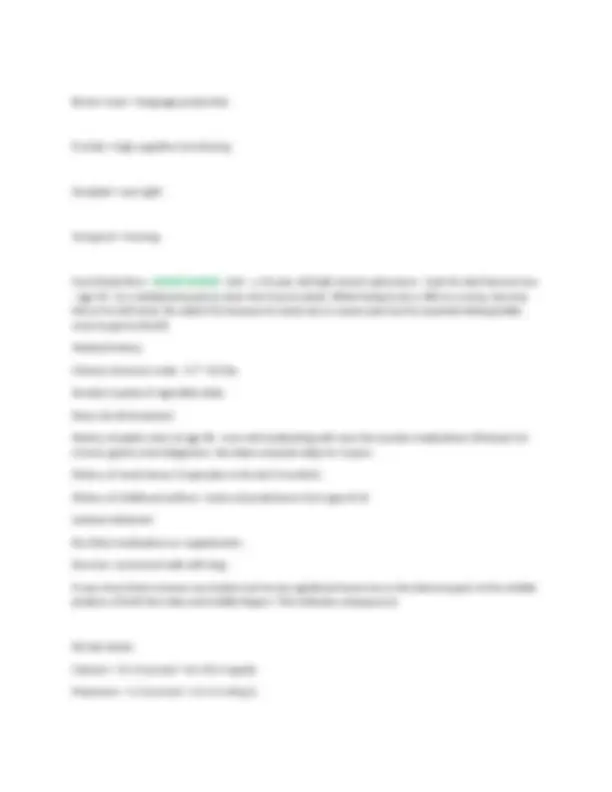
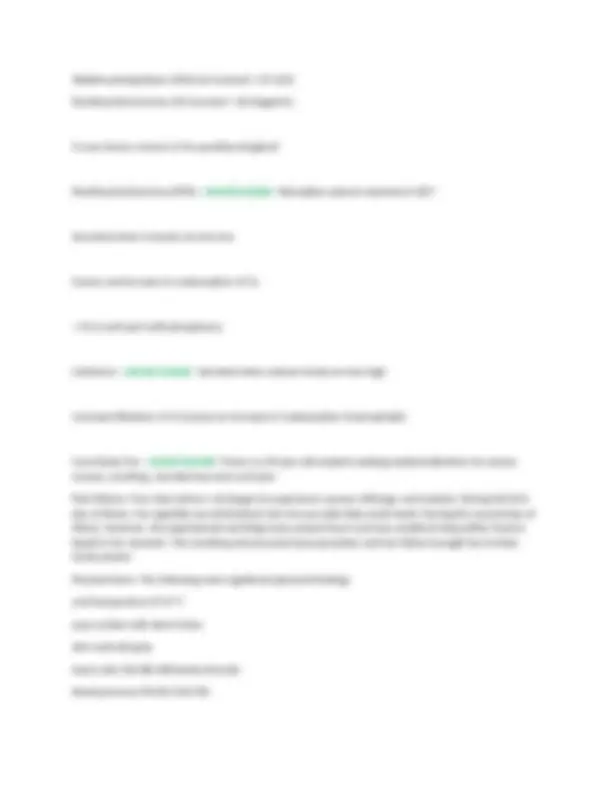



Study with the several resources on Docsity

Earn points by helping other students or get them with a premium plan


Prepare for your exams
Study with the several resources on Docsity

Earn points to download
Earn points by helping other students or get them with a premium plan
Community
Ask the community for help and clear up your study doubts
Discover the best universities in your country according to Docsity users
Free resources
Download our free guides on studying techniques, anxiety management strategies, and thesis advice from Docsity tutors
Physiology Final Exam - Case Studies Exam Graded A+.
Typology: Exams
1 / 35

This page cannot be seen from the preview
Don't miss anything!




























Case Study One - correct answer Sue had a cold, which has progressively gotten worse. She is now coughing up yellow to brown colored mucus and has a fever of 103 degrees. She is finding it difficult to breathe. She goes to her doctor who gives her a full exam and orders blood work and a chest x-ray. Lab results: Elevated blood cell count Arterial blood pO2 - 70mmHg (normal values = 75-100 mmHg) Arterial blood pCO2- 48 mmHg (normal range = 35-45 mmHg) Sputum sample shows the presence of Streptococci bacteria. X-ray shows fluid build up in the one lung Doctor diagnoses her with bacterial pneumonia and prescribes antibiotics and albuterol (a bronchial dilator - beta2 adrenergic agonist). Pneumonia is a lung infection caused by viruses or bacteria. The infection and inflammation causes excessive secretions that interferes with normal gas exchange between the lung tissue and the blood. Functions of Respiratory System - correct answer Oxygen/carbon dioxide exchange Acid/base balance Route for water loss and heat elimination Enhances venous return (cardiac output and BP) Enables speech, hiccups, cooling food, blowing up balloons, laughing Pulmonary Ventilation - correct answer Breathing; air in and out
External Respiration - correct answer Gas exchange between lungs and blood Tidal Volume - correct answer The volume of gas inspired or expired in an unforced respiratory cycle Total Lung Capacity - correct answer The total amount of gas in the lungs after a maximum expiration Vital Capacity - correct answer The maximum amount of gas that can be expired after a maximum inspiration Lung Compliance - correct answer How much effort is required to stretch/distend lungs Surfactant - correct answer Reduces surface tension; allows for more stretch to increase lung compliance Simple Diffusion - correct answer Lungs share thin basement membranes for easy gas exchange (diffusion); passive Fick's Law - correct answer Rate = change in concentration x membrane permeability / distance x molecular weight Top is direct with rate Inflammation - correct answer Macrophages in area begin phagocytizing bacteria or other foreign invaders. Secrete chemotaxins and cytokines that attract other phagocytes to the area and causes vasodilation/increased permeability. Increased blood flow to area and increased capillary permeability due to histamine. (redness - heat - swelling) Fever - correct answer Exogenous pyrogen (bacteria or the like) or endogenous (cytokines released by leukocytes) cause hypothalamus to reset body temp
IgM - correct answer Antigen receptor on lymphocyte surface prior to immunization Secreted during primary response In the plasma IgA - correct answer Main antibody type in external secretions (saliva and mother's milk) Binds to pathogen to prevent from entering body IgD - correct answer Antigen receptor on lymphocyte surface prior to immunization On the surface of B Cells IgG - correct answer Main form of antibodies in circulation Production is increased after immunization Secreted during secondary response In the plasma IgE - correct answer Responsible for allergic symptoms in immediate hypersensitive reactions T Cells - correct answer Attack the inside of cells Cell mediated immunity
Cytotoxic T Cells - correct answer When in contact with "bad" cell, it punches a hole in it and inserts a protein called perforin (CD8). Helper T Cells - correct answer The majority of T cells that signals there is a problem, but does not actually kill the invader (CD4) Major Histocompatibility Complex - correct answer Set of proteins that are on the surface of all body cells and it recognizes what cells are yours Class I = found on all body cells Class II = only on immune cells; antigen presenting cells Erythrocytes - correct answer Biconcave discs, enucleate, contains hemoglobin Function: transport oxygen and carbon dioxide Lifespan: 100-120 days Leukocytes - correct answer White blood cells Function: aid in the defense against infections by microorganisms Granulocytes - correct answer Twice the size of RBC and contain granules Lifespan: 12hrs-3 days Neutrophils - correct answer Granulocyte that has a nucleus with 2-5 lobes Function: phagocytic
Hemocytoblast - correct answer Stem cell for all blood cells Megakaryocyte - correct answer Cell that fragments to form platelets Hemostasis of Bleeding - correct answer Reactions for stoppage of bleeding 1.Vascular spasms 2.Platelet plug formation 3.Coagulation Diapedesis - correct answer Passing of leukocytes through the blood stream How is Oxygen Carried in the Blood? - correct answer Hemoglobin - binds to iron group Plasma - dissolved O How is Carbon Dioxide Carried in the Blood? - correct answer 1. Dissolved plasma 2.Hemoglobin 3.Bicarbonate (carries the most) Bohr Effect - correct answer When CO2 binds to hemoglobin and interacts with water, the additional H+ reduces hemoglobin's affinity for oxygen Decreased Attraction of Hb to O2, Right shift caused by an increase in PCO2. Haldane Effect - correct answer When oxygen binds to hemoglobin it displaces the CO2 from hemoglobin
Deoxygenation of the blood increases its capacity to carry CO2 in the form of Carbamino hemoglobin Oxygen Saturation Curve - correct answer Left = increases like for O2, will not let go Right = decreases like for O2, O2 will leave faster Ventilation Perfusion Coupling - correct answer Matching of airflow in lungs to blood flow in capillaries Body responds to a disrupt in levels with capillary bed and size of bronchiole Arterioles - correct answer Effected by O2 levels High O2 = vasodilation Low O2 = vasoconstriction Bronchioles - correct answer Effected by CO High CO2 = reduced ventilation, vasoconstriction Low CO2 = enhanced ventilation, vasodilation Metabolic Acidosis - correct answer pH < 7. HCO3 < 22 CO2 = normal Metabolic Alkalosis - correct answer pH > 7. HCO3 > 26 CO2 = normal
Respiratory Alkalosis: pH high/ CO2 low/ CO3 low Metabolic Acidosis: pH low/ CO2 low/ CO3 low Metabolic Alkalosis: pH high/ CO2 high/ CO3 high Full Compensation - correct answer When pH levels are returned to normal range (can be high or low) Respiratory Acidosis: pH low normal/ CO2 high/ CO3 high Respiratory Alkalosis: pH high normal/ CO2 low/ CO3 low Metabolic Acidosis: pH low normal/ CO2 low/ CO3 low Metabolic Alkalosis: pH high normal/ CO2 high/ CO3 high Cholinergic Synapses - correct answer Acetylcholine binds during first (ganglionic transmitter) and second (neuroeffector transmitter) synaptic point Nicotinic and Muscarinic receptor types In parasympathetic system Nicotinic Receptors - correct answer Opens Na/K gate; fast response Muscarinic Receptor - correct answer Second messenger; slow response Happens at rest and relaxation
Adrenergic Synapse - correct answer Norepinephrine binds during second (neuroeffector) synaptic point Alpha and Beta receptor types In sympathetic Alpha I&II Receptors - correct answer I: smooth muscle, vascular muscle > vasoconstriction II: presynaptic neurons > decreases release of Na, Ach, and insulin Beta I,II&III Receptors - correct answer I: cardiac muscle > excitatory (increases HR) II: smooth muscle > inhibitory (relaxation) III: increase adipose tissue use (fat burning) Case Study Two - correct answer Shayna is a 25 year old African American female. Shayna has been experiencing lower back pain that has become progressively worse over the last 3 months. After participating in a 3 days walk for charity, she discovered she had difficulty walking. She noticed that her legs would "give out", initially starting on the right side, then progressing to include both legs. She tried massage therapy, and when that did not work, she sought medical attention. Her doctor ordered a full medical workup, including magnetic resonance imaging of the brain and entire spine. A detailed history revealed symptoms of proximal weakness and autonomic dysfunction. She showed no signs of muscle atrophy, and had full range of motion and function in all major muscles and joints in her upper and lower extremities. However, the results of electrodiagnostic tests were consistent with presynaptic neuromuscular junction disorder, specifically Lambert-Eaton myasthenic syndrome (LEMS). LEMS is an autoimmune disease in which the patient's own antibodies attack presynaptic calcium channels at the neuromusclular junction, decreasing the ability of these calcium channels to open when stimulated.
Lectin Pathway Complement System - correct answer Mannose binding lectin binds mannose on pathogen surfaces Alternative Pathway Complement System - correct answer Binds directly to pathogen surfaces Interferon - correct answer Cytokine that interferes with viral replication Incomplete Antigen - correct answer Reactive to immune system products; hapten Complete Antigen - correct answer Immunogenic (creates an immune response) and reactive Antigen - correct answer Anything body sees as foreign Epitope - correct answer Specific binding sites on antigens for antibodies Primary Immune Response - correct answer First time exposure to pathogen/antigen Secondary Immune Response - correct answer Second time exposure to pathogen/antigen Neuromuscular Junction Steps of Impulse Across a Synapse - correct answer 1.Action potential comes down neuron 2.Voltage regulated Calcium gates open up 3.Calcium enters synaptic bulb and binds to vesicles of ACh 4.Vesicles rise to surface for exocytosis 5.Releases Ach into synapse 6.Ach diffuses across and binds to receptor on motor endplate/sarcolemma 7.Causes ion channels to open up 8.Sodium flows in, potassium flows out (opens ion channel)
9.Causes depolarization (graded potential) 10.Generates action potential down T Tubule 11.Stimulates opening of sarcoplasmic reticulum 12.Sarcoplasmic reticulum release calcium 13.Binds to troponin 14.Troponin changes shape rolls off attachment site 15.Myosin heads reach up to attach and pull Role of Calcium in Skeletal Muscle Contractions - correct answer Fully Developed SR and T-tubules Majority of calcium from SR Ca++ binds to troponin; troponin moves tropomyosin away from binding site; allows for myosin to bind to actin; produces tension and shortening Role of Calcium in Cardiac Muscle Contractions - correct answer Partially developed SR and T-tubule Calcium comes from SR and extracellular fluid Role of Calcium in Smooth Muscle Contractions - correct answer Underdeveloped SR and T-tubule; no troponin Majority of calcium comes from extracellular fluid Ca++ binds calmodulin in cytosol; binds to myosin light chain kinase; uses ATP to phosphorylate myosin cross bridges; then binds to actin; produces tension and shortening Action Potential of Autorhythmic Cells - correct answer Internal conduction system
Arranged in sarcomeres to create striated appearance Structure of Cardiac Muscle - correct answer Two nuclei that are centrally located, striated, branching, intercalated discs Structure of Smooth Muscle - correct answer Spindle-shaped, single nucleus, no branching, no striations, under-developed SR DO NOT contain troponin, sarcomeres Only tropomyosin, actin and myosin Multi-Unit Muscle - correct answer Cells are not connected; act separately Each cell needs to be told to contract Single Unit Muscle - correct answer Connects through a gap junction that functions as one cell Characteristics for Muscle Fibers - correct answer Multi-nucleate, striated, un-branching, T-tubules (fully developed), Sarcoplasmic reticulum (stores calcium - fully developed) 3 types of muscle fibers One muscle = mixture of fibers Single motor unit = all muscle fibers of same type Sarcomere - correct answer A band = length of thick filament; doesn't change I band = thin filament only; changes shape upon contraction Z disc = separation of sarcomeres; where thin filaments bind
M line = middle of sarcomere Slow Oxidative Fibers - correct answer Low myosin ATPase High oxidative capacity - aerobic (mitochondria, rich blood supply, myoglobin-red) Small diameter (little tension, small diffusion barrier) Fatigue slowly Speed of contract = Slow Fast Oxidative Fibers - correct answer High myosin ATPase activity High oxidative capacity - aerobic Myoglobin Slow to fatigue, but more rapid than slow oxidative Speed of contraction = Intermediate Intermediate diameter Fast Glycolytic Fibers - correct answer High myosin ATPase activity High glycolytic capacity (high glycogen stores, many glycolytic enzymes) No myoglobin (appear white)
ISPS - correct answer Inhibitory Postsynaptic Potential Opening of chloride or potassium channels results in a graded hyperpolarization ESPS - correct answer Excitatory Postsynaptic Potential Opening of sodium and calcium channels results in a graded depolarization Voltage Regulated Channels - correct answer Require a change in voltage to open and close channels; produce action potential Chemically Regulated Channels - correct answer Require chemical stimulation to open and close channels; produce graded potentials Case Study Three - correct answer Mr. Jones, age 77, is a retired middle school history teacher. He has been brought to the ER from a nearby casino - he began having difficulty breathing after only 20 minutes playing the slots. He had taken a bus to the casino (3 hour drive) and had taken Benadryl so he could sleep on the bus. He has a history of "heart failure" and "COPD" but he did not bring any of his medications with him. His dyspnea responded to oxygen, an inhaled beta 2 agonist (albuterol), and inhaled Atrovent (a short acting anti-cholinergic drug). His arterial blood gas values were: pO2 = 55 mmHg (normal - 75-100) Oxygen saturation = 88% (normal = 94-98%) pCO2 = 46 mmHg (normal = 35-45 mmHg) pH = 7.30 (normal = 7.35-7.45) HCO3 = 30 (normal = 22-26 mEq/L) He has pitting edema of his feet. An ECH (EKG) is taken and he has non-specific T wave abnormalities and a prolonged PR interval. He has an echocardiogram which determines he has left ventricular hypertrophy and ventricular ejection value
of less than 60%. He is given Lasix (a diuretic medicine that reduces sodium and water reabsorption from the loop of Henle). pQRSt Wave - correct answer p wave = atrial depolarization (from SA node to AV node) QRS complex = ventricular depolarization; atrial repolarization t wave = ventricular repolarization Systole - correct answer Contraction of heart muscle Peak pressure exerted by ejected blood against vessel walls during contraction Diastole - correct answer Relaxation of heart muscle Minimum pressure in arteries when blood is draining off into vessels down stream End-Diastolic Volume - correct answer EDV = blood in ventricle during relaxation The maximum volume of blood that the ventricle contains after filling is complete End-Systolic Volume - correct answer ESV = amount of blood remaining in ventricle after contraction The minimum volume of blood that the ventricle contains after emptying is complete Stroke Volume - correct answer Amount of blood pumped out per contraction EDV-ESV = SV Cardiac Output - correct answer CO= HR x SV